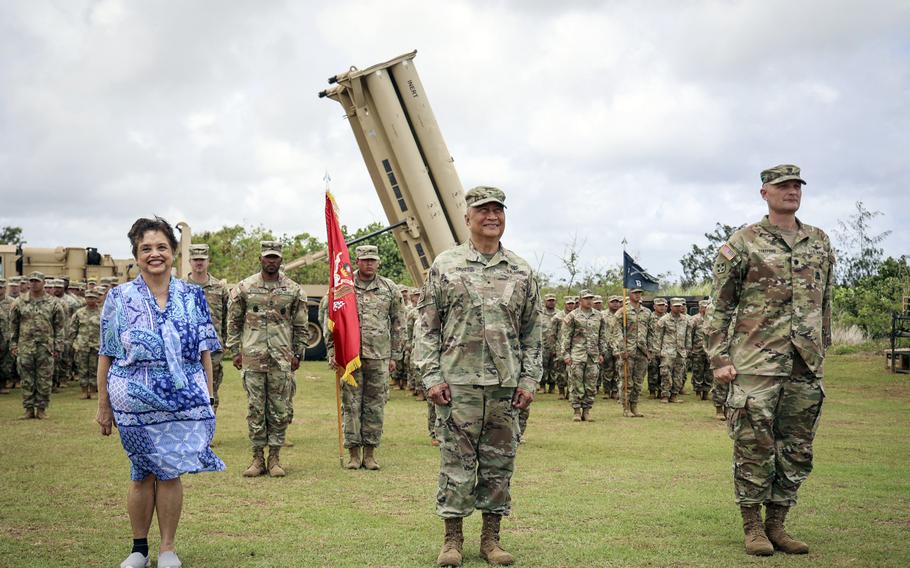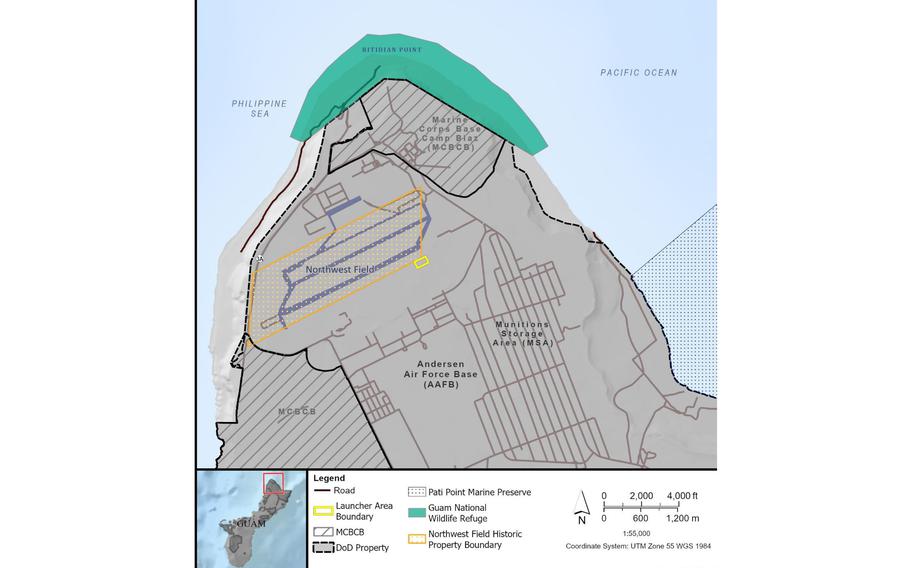
Guam Gov. Lou Leon Guerrero poses beside Brig. Gen. Michael Cruz, adjutant general of the Guam National Guard, center, and Lt. Col. Jonathan Stafford, commander of Task Force Talon, during a visit to the Terminal High Altitude Area Defense, or THAAD, site, on Guam, May 9, 2024. (Mark Scott/U.S. National Guard)
The U.S. military plans to conduct up to two live-fire missile defense tests each year over the next decade from Guam as it develops an integrated defense system for the strategically important island.
The Missile Defense Agency released a 378-page environmental assessment Saturday laying out its plan to track and destroy target missiles in cooperation with the Air Force, Army, Navy and Coast Guard. The tests would begin sometime in the last three months of this year.
The assessment concluded that “no significant direct, indirect, or cumulative environmental impacts” would occur from the testing.
The agency is soliciting public comment on the assessment through July 2.
“A missile defense system provides a layered defense consisting of various land-, sea-, and air-based weapons; sensor and communications systems; and command and control platforms that are used to defeat incoming ballistic, cruise, and hypersonic missiles in all phases of flight,” the assessment states.
Indo-Pacific Command sees completion of the Guam Missile Defense System as a top priority for the region.
The U.S. territory is home to Andersen Air Force Base, Naval Base Guam and Camp Blaz, a massive Marine Corps base still under construction.
The island would serve as a crucial hub in the event of a conflict with China because it is the westernmost American territory and closest to the South China Sea, a flashpoint in the region.

A map of the northern tip of Guam published by the Missile Defense Agency outlines in yellow the portion of Andersen Air Force Base to be used to launch missile defense interceptors. (Missile Defense Agency)
The assessment was greeted warily by the Pacific Center for Island Security, a Guam-based group that describes itself as “an action-oriented research institute that aims to anchor this island and islander perspective.”
“In view of the coming plans for Guam that are not of our making or choosing, it is imperative that an all-Guam approach be launched to protect the essential value of our island and our future,” the center’s chairman, Robert Underwood, said in a statement Monday.
“As billions of dollars are flowing for military projects, the community in Guam is not being planned for,” he said. “Today, the military has not planned for enough housing for their own troops and contractors that they plan to bring to Guam.”
The two annual flight tests or tracking exercises would be conducted from Andersen or from a U.S. Navy ship afloat in the Western Pacific, the assessment states.
“A flight test represents a target missile flight, an interceptor missile flight, an intercept of a target missile, or a test of sensors independent of missile flight,” the assessment states. “For a single flight test, multiple interceptors and targets may be utilized.”
A tracking exercise uses sensors to scan and trace a target, but an interceptor is not typically used.
The first test later this year would involve launching an interceptor called Standard Missile-3 using the Aegis Weapon System from Andersen against a medium-range ballistic missile, the assessment states.
That target would be air-launched from a C-17 Globemaster at an altitude greater than 20,000 feet and at least 800 nautical miles east of Guam over the Pacific Ocean.
The first-stage booster from the interceptor would separate and land in a remote area of Andersen, the assessment states.
Debris from the intercepted target “would fall to the surface of the ocean greater than 88 nautical miles from Guam and sink to the ocean floor,” the assessment states.
Future flight tests and tracking exercises would use the interceptors from the Terminal High Altitude Area Defense, or THAAD, and Patriot systems.
The tests would eventually include the not-yet-fielded Indirect Fire Protection Capability, or IFPC — a mobile, ground-based system used to defeat cruise missiles, drones, rockets and mortars.
The tests will validate the military’s capability of integrating multiple sensors and interceptors that will become the “backbone” of the Guam Missile Defense System, the assessment states.
The assessment is available at www.mda.mil/system/GuamFT/ea.html. Comments can be emailed to info@GFT-EA.com or mailed to ManTech International Corporation, Attention: Guam Flight Test EA Project Support, PMB 403, 1270 N. Marine Corps Dr., Suite 101, Tamuning, Guam 96913-4331.